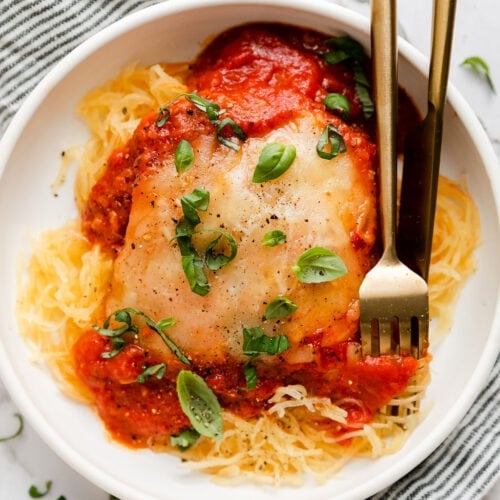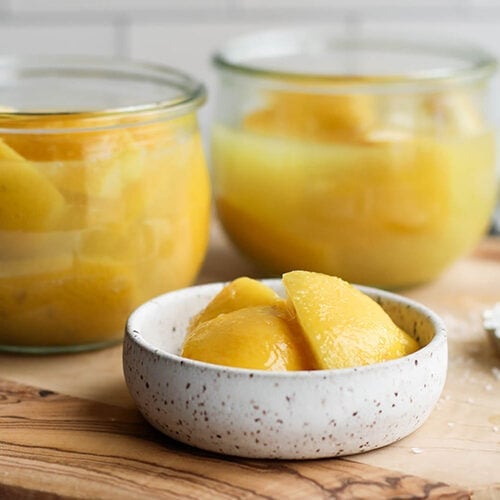Sauteed asparagus is one of the easiest side dishes to include with your spring and summer meals. We’ve designed a recipe you can use with or without toppings that will elevate your side dish to make it feel fancy and delicious! This is the best sauteed asparagus you’ll ever have.
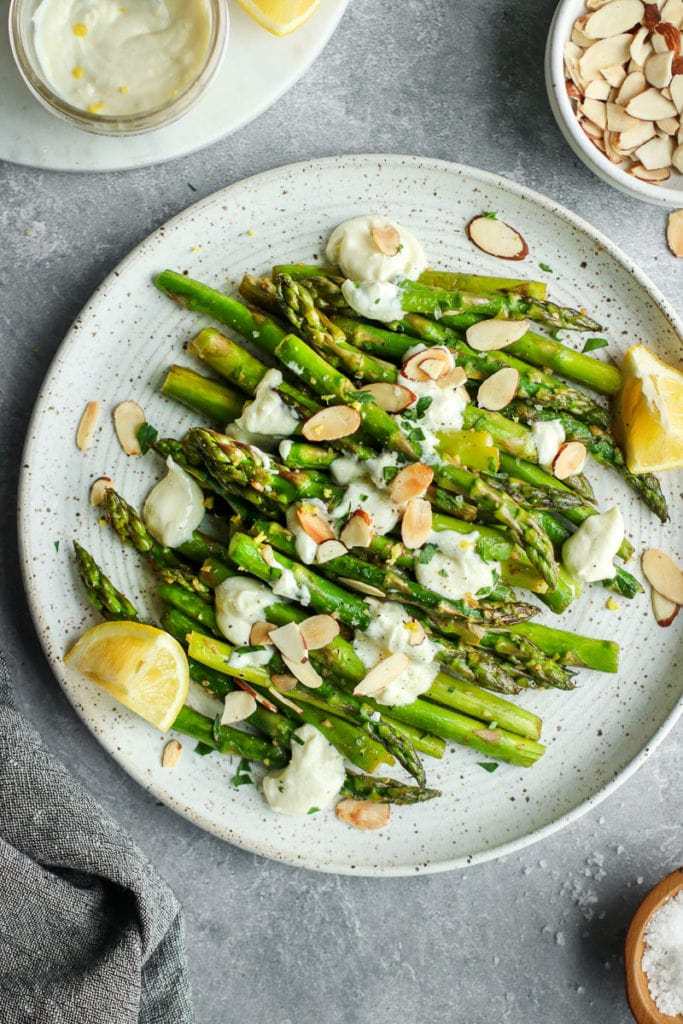
What is the best way to cook and eat fresh asparagus?
The best way to cook and eat asparagus is hard to choose, but sauteing it is one of our favorite ways.
But that’s not your only option! You can sauté it in a cast iron skillet or pan fry it with unsalted butter, throw it in the air fryer with kosher salt and garlic, serve it as a side dish, or main dish, or toss it into a stir fry.
Asparagus is a highly versatile veggie rich in vitamin A, vitamin C, and folic acid.
Asparagus Is the Perfect Spring & Summer Side Veggie
Asparagus is the perfect healthy side dish to bring to your spring picnics and summer BBQs. It grows primarily in late February and early June and will be at its freshest during those months.
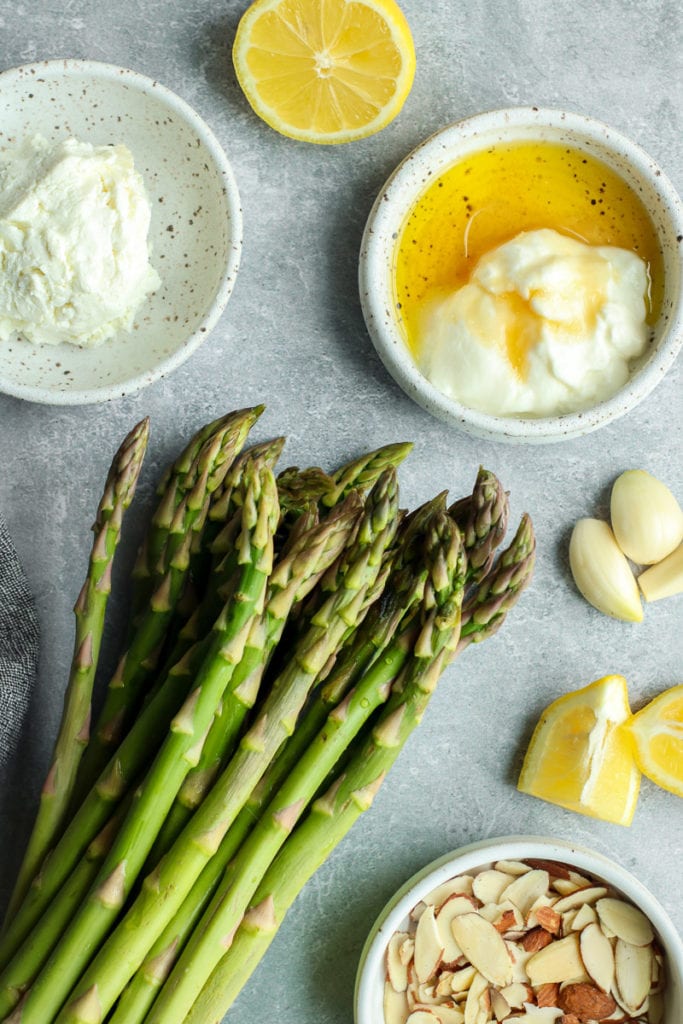
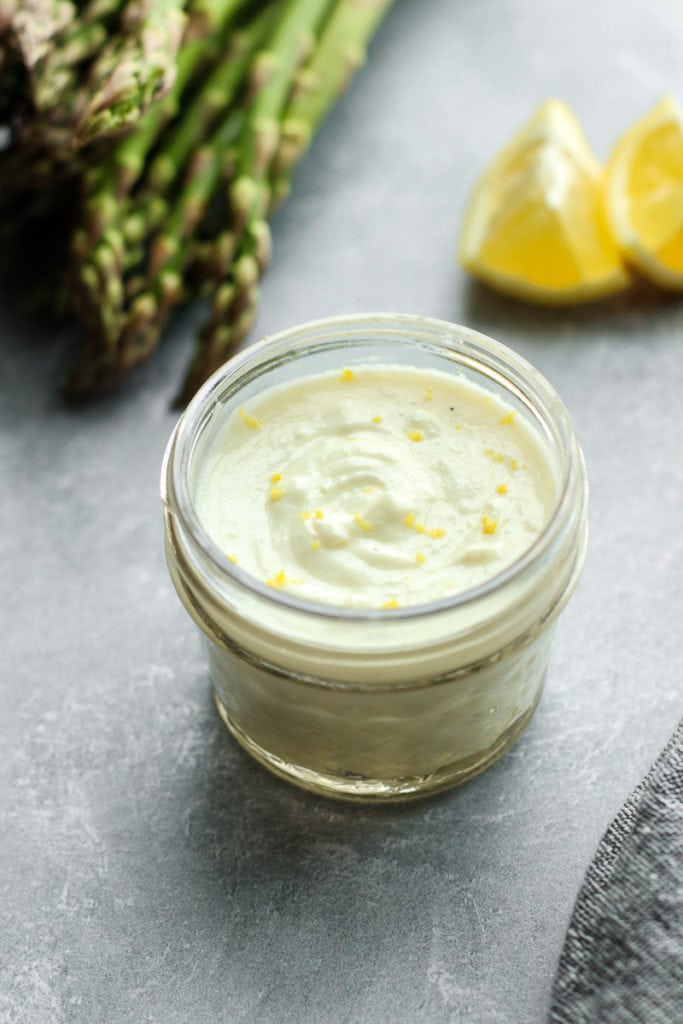
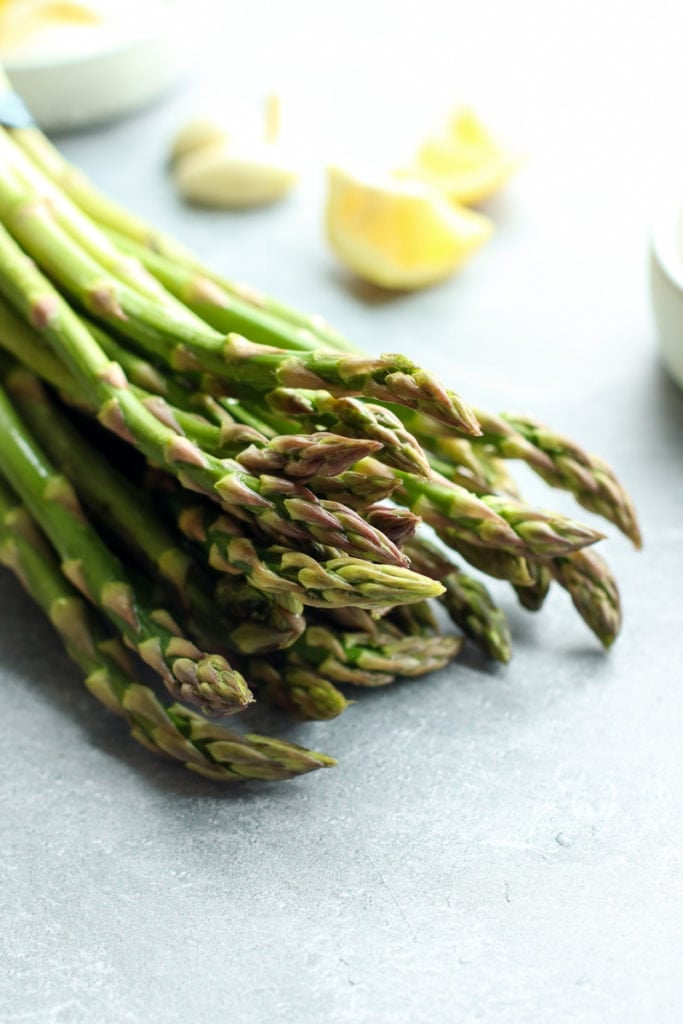
Tips For Sautéing Asparagus Just Right
To make sauteed asparagus just right, heat olive oil in a skillet over medium-high heat. Add asparagus to the skillet and sauté until tender, turning as needed. Cook time will vary based on the size of the asparagus:
- thin asparagus (¼'” diameter): 3-4 minutes
- medium asparagus (⅓” diameter): 4-6 minutes
- thick asparagus (½” diameter): 6-10 minutes
If your asparagus stalks have tough ends or woody ends, you can trim the asparagus until it’s not tough.
Here’s a short step-by-step guide on how to make the perfect sauteed asparagus:
- Place your skillet over medium-high heat.
- Once the skillet is hot, add oil and swirl to coat the bottom.
- When the oil starts to shimmer, add the asparagus.
- Cook for 7-8 minutes or until asparagus is crisp-tender to your liking, stirring every 1-2 minutes.
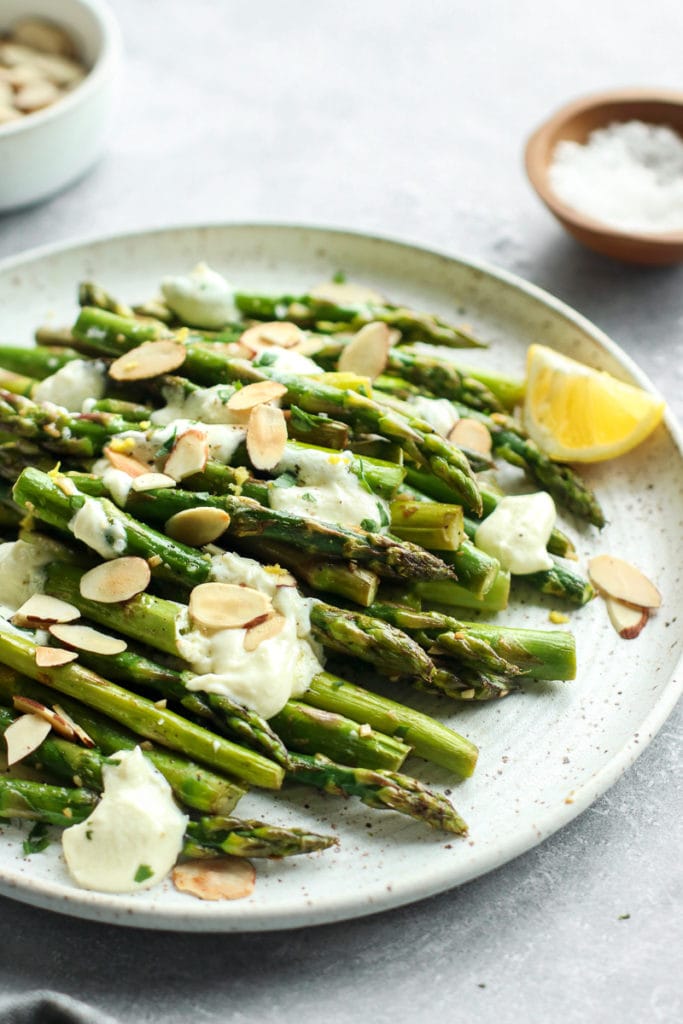
The Best Ingredients For Sautéed Asparagus
Use these ingredients for a simple recipe:
- Asparagus spears (trim asparagus and cut stalks in half to make approximately 3-inch pieces)
- Avocado oil or olive oil (we like Primal Kitchen Olive Oil or Avocado Oil)
- Garlic cloves
- Fine salt and black pepper
These optional ingredients give this dish a little more flare:
- Soft goat cheese (room temperature)
- Sliced almonds (omit for nut-free)
- Plain yogurt (we recommend full-fat or 2%)
- Fresh lemon juice (We recommend squeezing fresh lemon juice. Check out this manual juicer.)
- Honey (you can easily omit it for no-added-sugar)
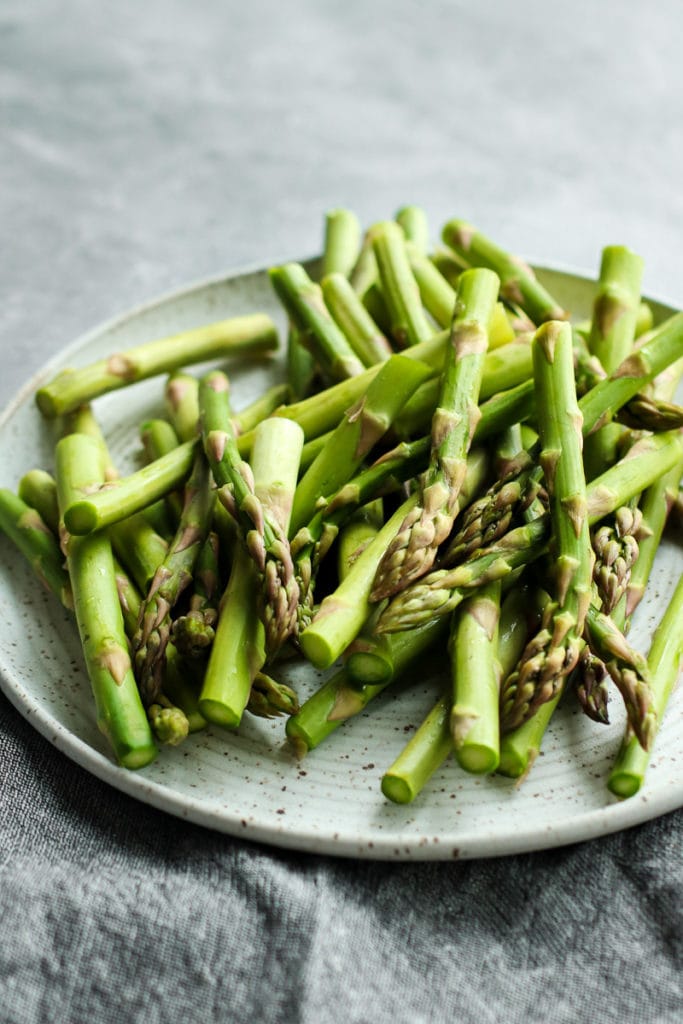
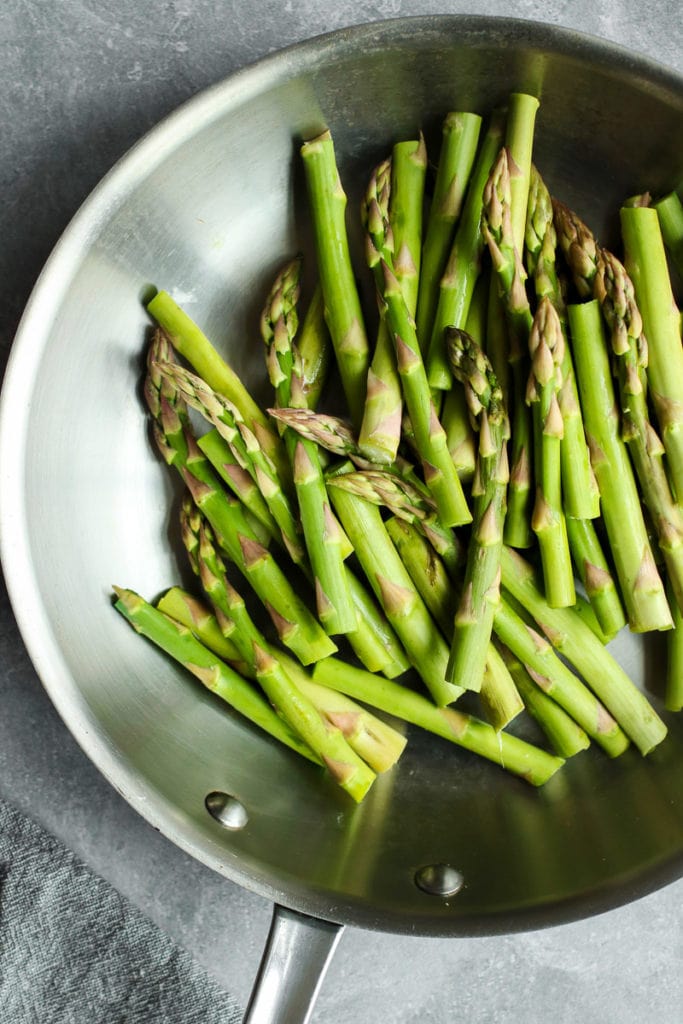
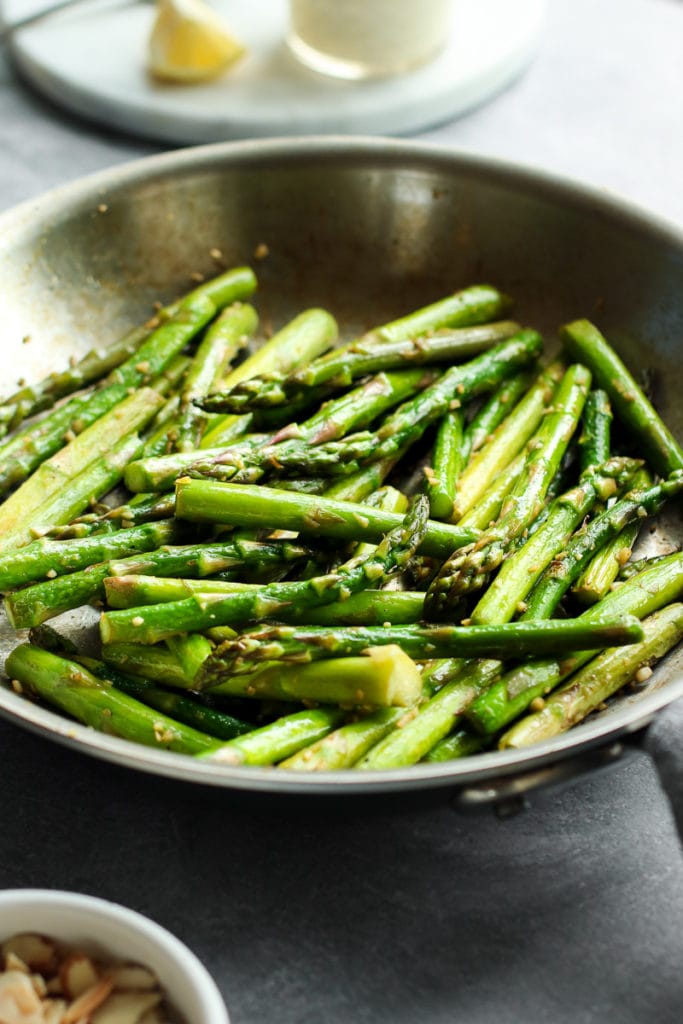
Elevate This Side Dish With Goat Cheese and Sliced Almonds
Sauteed asparagus is delicious by itself, but if you are looking for an extra pop of flavor, asparagus and goat cheese are delicious additions! The sauce compliments this vegetable side dish so well that your guests will be begging for more.
Not only is this sauce extremely flavorful, it’s also versatile. If you’re lucky, you might wind up with some leftover sauce — which we promise, is a good problem to have. This sauce is also delicious when drizzled over a lettuce wrap or sandwich.
You may also love our lemon goat cheese sauce as a dip for sweet potato fries, roasted root vegetable fries, chicken, or fish.
Other delicious asparagus toppings to switch it up might include:
- Parmesan cheese
- Pine nuts
- Minced garlic
- Garlic butter
The Best Way To Store Asparagus Before Cooking
Asparagus tastes best when cooked the day you buy it. If that’s not in the cards for you, store the stalks as you would store cut flowers:
- Trim the woody ends
- Stand the spears up in a glass or jar with about an inch of water
- Cover with a plastic bag
- Refrigerate for up to 4 days
Do I need to blanch asparagus before sautéing it?
Asparagus does not need to be blanched before sautéing.
Green vs. White Asparagus
White asparagus is grown underground, whereas green asparagus is grown above the ground.
White asparagus is fully covered with dirt and gets no sunlight, which means it can’t produce chlorophyll. Green asparagus, on the other hand, gets access to sunlight, which allows it to produce chlorophyll and turns bright green.
That’s why green asparagus is the healthier option of the two.
What To Serve With Sautéed Asparagus
Here are popular options to serve alongside your sauteed asparagus:
- Juicy, grilled chicken breast (Don’t want to fire up the grill? Check out this post: How to Make the Perfect Chicken Breast)
- Flaky grilled fish
- Italian turkey zucchini Meatballs
- Grilled steak kebabs
- Grilled or Air fryer salmon
- Seared scallops
- Crab cakes
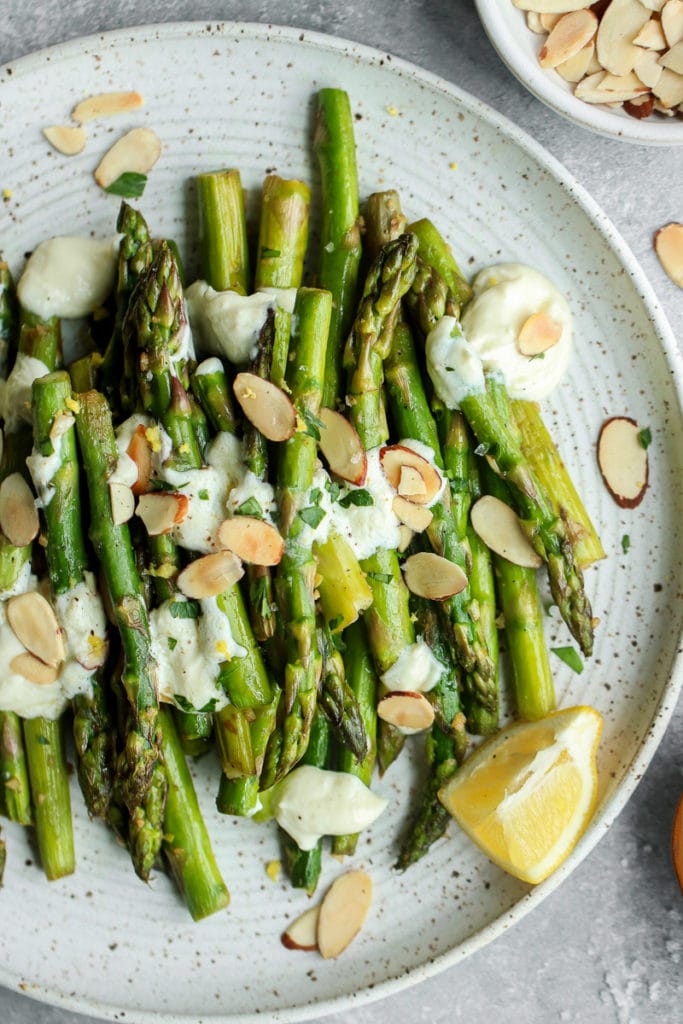
Benefits Of Eating Asparagus
What are the benefits of eating asparagus? Asparagus is high in vitamin A, vitamin B, and folic acid. Pregnant women often take folic acid supplements to support brain growth in their babies during pregnancy. Asparagus is chock full of antioxidants, fiber, and supports an overall healthy body function.
How To Store Cooked Asparagus
To store cooked asparagus, place the leftover spears in a shallow airtight container, such as a freezer bag or plastic food container. You can also tightly wrap your asparagus in heavy-duty aluminum foil or plastic wrap. You may reheat your asparagus to enjoy again with zero prep time!
Want to save this recipe?
Enter your email below & we’ll send it straight to your inbox. Plus you’ll get great new recipes from us every week!
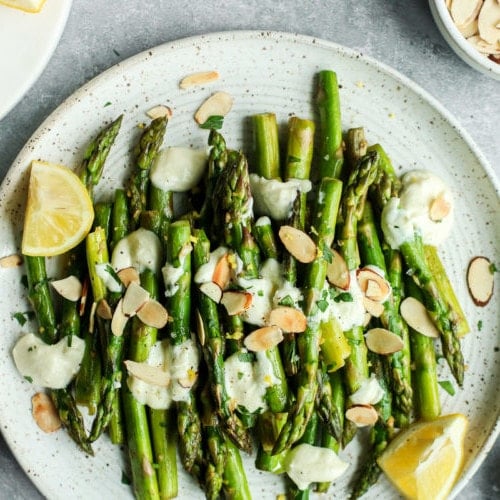
Sautéed Asparagus
Crisp-tender, perfectly sautéed asparagus is topped with toasted almonds and a garlicky, lemon goat cheese sauce.
Ingredients
For the Sautéed Asparagus:
- ⅓ cup sliced almonds, toasted
- 2 teaspoons avocado oil or olive oil
- 1 – 1 ¼ pound asparagus spears, ends trimmed and cut in half (about 3-inch pieces)
- 1 garlic clove, minced
- Lemon juice
- Fine salt and pepper
- Optional for garnish: lemon zest and/or fresh chopped parsley
For the Lemon Goat Cheese Sauce (optional):
- 2 ounces soft goat cheese, room temperature
- 2 tablespoon plain yogurt (full fat or 2%)
- 1 small garlic clove, minced
- 1 tablespoon fresh lemon juice
- 1 teaspoon honey
- 2 teaspoons avocado oil or olive oil
- Water
Instructions
- Place large skillet over medium-high heat. When the skillet is hot, add the oil and swirl to coat the bottom.
- When the oil starts to shimmer, add the asparagus.
- Cook for 8 minutes, stirring every 1-2 minutes.
- Add the garlic and continue to cook for another 2-3 minutes or until asparagus is crisp-tender to your liking.
- Once cooked, add a squeeze of lemon juice and a dash of salt and pepper to taste.
- Transfer the asparagus to a serving platter and add your toppings (if any).
- Garnish with lemon zest and fresh chopped parsley, if desired.
- Store any leftovers in an airtight container in the fridge for up to 3 days.
Optional Instructions (goat cheese sauce)
- In a small food processor or blender, combine all of the sauce ingredients.
- Process or blend until smooth, adding a little water (1 tablespoon at a time) if necessary to achieve a smooth consistency.
Optional Instructions (toasted almonds)
- Place a large skillet over medium heat.
- When the skillet is hot, add the almonds and toast, stirring often, for 6-8 minutes or until they are golden and give off a toasted aroma.
- Transfer the almonds to a plate to cool.
Last Step! Please leave a review and rating letting us know how you liked this recipe! This helps our business thrive so we can continue providing free recipes and high-quality content for you.
Nutrition Information
- Serving Size: 1/6 of recipe + 1 tablespoon sauce
- Calories: 90
- Fat: 7 g
- (Sat Fat: 2 g)
- Sodium: 160 mg
- Carbohydrate: 4 g
- (Fiber: 1 g
- Sugar: 2 g)
- Protein: 4 g
Dietary
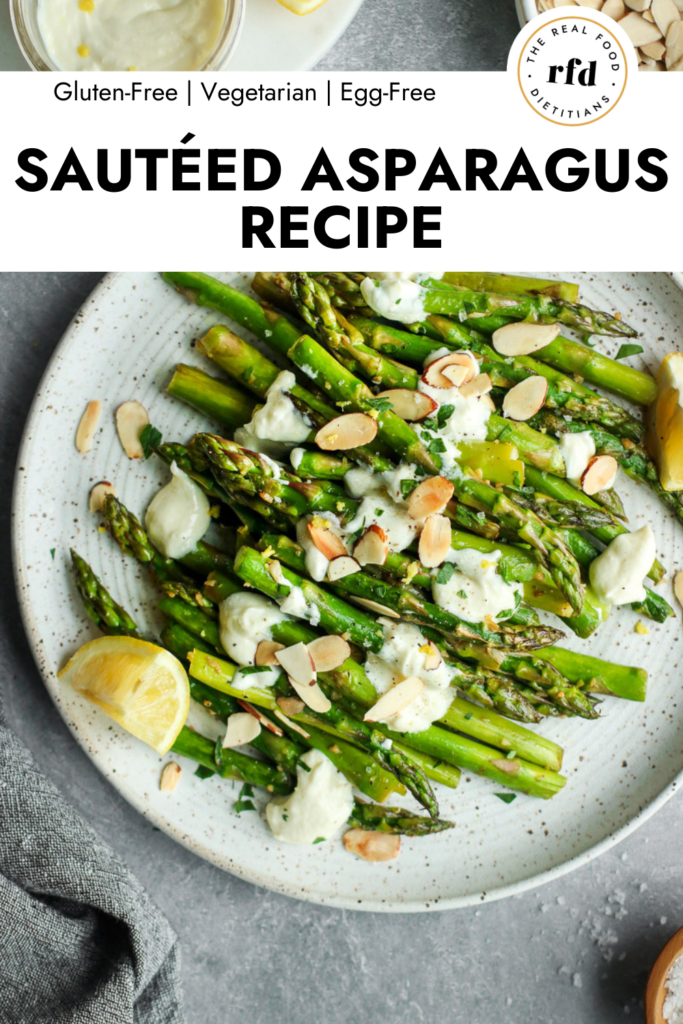
This post may contain affiliate links which won’t change your price but will share some commission.
All photos and content are copyright protected. Please do not use our photos without prior written permission. If you wish to republish this recipe, please rewrite the recipe in your own unique words and link back to the source recipe here on The Real Food Dietitians. Thank you!
